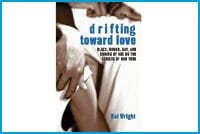Kai Wright, a New York journalist and author of two books on African-American history, opens Drifting Toward Love: Black, Brown, Gay and Coming of Age on the Streets of New York, his chronicle of young gay lives, with a guilt-tinged personal disclosure. Repetition never dulls the stab of despair I feel whenever I hear a guy confess to casual barebacking. Then the slump morphs into anger. I want to bray like Larry Kramer, quoted here after Wright’s story of brainless abandon: “Are you out of your fucking minds?!”
It’s the quality of confession that makes the difference. Wright’s point is that you don’t have to be a club bunny cliché to find yourself risking all in a few moments of lust. It’s as if the knowledge of his own fragility has fuelled this quietly passionate, sometimes dispiriting, finally inspiring book.
Manny (all names have been changed) was raised by his social worker mom in a Brooklyn neighbourhood of “black and brown” families in nondescript apartment blocks. At 14 he found himself suddenly in love with his longtime playmate, Jason, and they increasingly set aside their video games for secret sex. Around the same time, Manny took to riding the train into Manhattan and hanging with the YES (Youth Enrichment Services) crowd at the Village’s queer community centre, a place where kids “could come each day and just feel safe being a queer teen.” Manny plunged in, joining the planning sessions for a youth activist conference. Meanwhile he was learning that gay sex would not be discussed in his junior high classroom. The school board’s late 1990s sex-ed guidelines essentially let individual teachers set their own agenda.
Brooklyn’s huge Prospect Park has a long-standing cruising area dense with trees and underbrush. It’s here that Jason finally introduced 15-year-old Manny to the sideline he’d been earning extra cash at in hopes that they could work as a team. The first night in the flesh pits was a shock for Manny, as he watched his boyfriend disappear into the trees with a middle-aged white guy. But soon he was willingly offering “his mouth, his ass, his youth, his mocha-brown skin” to a parade of clients.
Julius is 22 when we meet him at a Brooklyn youth shelter. After a childhood shunted between foster homes, he’s underemployed and filling his empty days with web cruising. He’s turned the getting of sex into a fine art, maximizing the encounters he can tally within walking distance of any A-train station. If it looks like he’ll have to transfer trains, the potential trick gets a no-go message. To our gently prying author, Julius admits that for years, despite the risk of being a devoted bottom, he has used condoms for maybe one in five encounters. Why? He has no answer, though he concedes, “It boggles my mind.”
Wright introduces a handful of other young guys linked by friendships and circumstance. When he stays with these stumbling and seeking subjects, his writing has a gentle, cumulative power. The occasional downside comes with his odd detours into extraneous detail. Do we really need to learn about the origins of sugarcane farming in Puerto Rico, or the island’s 1930s unemployment stats? And is it news to anyone that “Yahoo hosts thousands of online groups” where people swap opinions “on electronic-messaging bulletin boards”?
Wright’s quick history of the Harlem drag ball scene is far more relevant, as is his brief aside on the recent evolution of Christopher St. The iconic street has become a vibrant hangout for queer teens too young for the bars but revelling in a collective sense of street theatre. But for all the celebratory identity rituals, there are a few that spiral into nightmare realms. Wright visits one in particular; it’s a heartbreaking journey. Then he guides us back to cautious hope.
We know that for many kids, shame and self-hatred are as powerful as they’ve ever been. It depends only on where you look and who you know. Here in comparatively liberal Canada, the effects may be less pervasive, but the individual dynamics are the same. When teenagers feel compelled to erase themselves — through drugs, risky sex, withdrawal — simply because they’re gay, it’s clear we’ve still got miles to go before our love can be set free. Kai Wright’s book is one part of the solution.

 Why you can trust Xtra
Why you can trust Xtra


